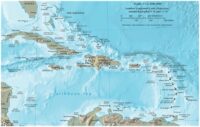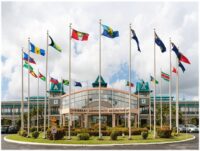
https://www.open-diplomacy.eu/blog/migratory-patterns-in-the-caribbean-impacts-and-perspectives-
forcaribbean#:~:text=The%20Caribbean%20countries%20have%20historically,scale%20incoming%2
0and%20outgoing%20migration.&text=It%20results%20in%20a%20very,policies%20and%20socio%
2Dcultural%20adaptations, Accessed 14 March 2021.
Introduction
The following is an assessment of the major push factors of migration in the Caribbean countries. I also discuss the positive and negative effects of emigration on the home countries while making recommendations to all the stakeholders to address the situation at local, national, and international levels. Ultimately, I seek to provide readers a basic understanding of several aspects of migration in the Caribbean region.
A Historical Overview of Migration in the Caribbean
In the literature on “migratory systems”, push factors are those that compel people to move to some other place (MedhiLalhou, 2006). The Caribbean region and migration have been synonyms for more than two centuries. The first great wave of migration to the Caribbean was through the Transatlantic Slave Trade. During this period (between 1550 -1850), more than five million enslaved Africans disembarked in the British and French Caribbean. In the 19th century, people from China and India moved to the Caribbean (Martinique, Jamaica, Trinidad, British Guiana, Guadeloupe, etc.) as indentured laborers on plantations.
From 1920 to 1980, due to demographic explosion, the decline of the plantation economy, and the building of modern communication infrastructures (railways, Panama Canal, etc.), the indigenous Caribbean residents started emigrating to other regional countries. Since the 1990s, people began leaving the region for reasons other than traditional push factors such as the lack of social mobility, persecution, government restrictions, human rights violations, gender inequality, political corruption, violence, natural disasters, and climate change. To understand migration in the Caribbean region, it is important to use a holistic and multidisciplinary approach because these “migratory systems” are based on many factors such as colonization, political influence, commerce, investment, and cultural ties. (Castles and Miller 2009).
Economic and social factors
Neoclassical Economics theorists (Adam Smith, 1776; FriederichRatzel, 1882; Ravenstein, 1889) highlight economic factors as the main reasons for emigration. The people of Caribbean origin are no exception. Lack of job opportunities, low salaries, poor economic activities, low career prospects, and economic crisis are some of the reasons why Caribbean people leave their countries. Countries such as The Bahamas, Caiman Islands, the Virgin Islands, Turks, and Caicos have the largest gross domestic product (GDP) per capita of the region. However, others such as Haiti, Dominican Republic, Cuba, and Jamaica still among the poorest in the world.
Salary disparities between workers of the Caribbean region and popular destination countries provide an incentive to emigrate (Gavin George et al., 2019). “Care drain” is a well-known situation in the Caribbean region. The results of a study conducted by Gavin Goerges and published in BMC Health Services Researchperformed on salary disparities between the Human Resources for Health (HRH) of home countries and host countries (UK, USA, and Canada) present a picture of reality. A registered nurse in the USA earns 214.2% more than her Caribbean counterpart ( George et al., 2019). The salary of a medical specialist in the USA is 540.4% higher than their Caribbean-based counterparts ( George et al., 2019).
Political factors
State persecution, corruption, lack of political liberties and rights, war, conflicts, and gang violence forced people of the Caribbean region to flee their home countries. Historically, the region is known for repressive political regimes and political instability. For instance, the Haitian refugee crisis is a consequence of political tensions that had been building in the country for more than two centuries. Additionally, the mass emigration of Cubans to the United States is mainly a consequence of the nature of the Castro regime.
There is strong social marginalization in the Caribbean region which stimulates insecurity. Added to this, the Caribbean region is subject to violence and organized crime groups. The region is a preferred route for drug trafficking between Central America and Europe (UNODC, 2008). Thus, the region has a very high murder rate (World Bank database, 2015). Insecurity and violence are key factors pushing people to emigrate (Clemens, 2011; Wood et al., 2012). This calls for measures and policies by governments to reduce violence so that the number of people emigrating will be reduced.

https://caricom.org/caricom-secretariat-headquarters-going-solar/, Accessed 14 March 2021.
Environmental factors
The Caribbean region regularly experiences natural disasters such as hurricanes, earthquakes, floods, and volcanic eruptions. This unfortunate situation results in both internal displacement and international migration. The best known-case is Haiti. Since 1994, the country has experienced ten natural disasters. The most dangerous was an earthquake of 7.0 magnitude in January 2010. According to the International Organization for Migration’s (IOM) Displacement Tracking Matrix (DTM), this disaster has damaged more than 300,000 homes and displaced 1.5 million people (IDPs) in 1,555 camps.
Environmental problems, particularly climate change are also significant factors influencing migration in the region. Many of the region’s asylum seekers in relatively safe countries (USA, Mexico, Brazil, and so forth) face great difficulties in their search for international protection because the status of climate refugees is a concept that divides scientists and official authorities. We have the example of the 46,000 Haitians who fled to the U.S. after the quake. More than ten years later, they still have a Temporary Protected Status.
Effects of migration on the Caribbean region
Migration specialists classify the effects of migration on home countries in two categories – positive and negative (Emma Aguila et al., 2012; Ricardo Faini, 2002). They list several of the positive impacts of emigration mainly through diaspora contributions/ investment in the country-of-origin. These include a decrease in the unemployment rate in the country-of-origin, investments in technology and capital in the home country, stimulation of investment in education, health, and human capital, support of diasporas which contribute to community development and diminish the impacts of natural disasters and ensure the inflow of remittances. For instance, Guyana, Haiti, Jamaica, Grenada, and the Dominican Republic are in the top 30 remittances-receiving countries worldwide (ACP Observatory on Migration, 2014, p.54).
Caribbean countries are also negatively affected by migration. Some of the negative consequences of emigration include brain drain, loss of tax income and qualified workers, and reduced economic growth and productivity. The receivers of remittances can be dependent; work ethic declines and this makes way for dependence culture. And the measurement of remittances in Caribbean countries is very complicated because many Caribbean migrants do not have bank accounts and use informal channels to send money to their countries. This means respective home country governments lose potential tax revenue that they could potentially get if the remittances were to be sent through formal channels. Caribbean children are also extremely affected by migration. In a recent report on the situation (UNICEF, 2009), experts mentioned that they risk losing the right to education and health due to indefinite periods of separation from their parents.
Conclusion
In a globalizing world, there will always be people on the move. Migration in the Caribbean region is both an issue and an opportunity. While it is sometimes seen as a huge challenge, it can play a major role in the economic, social and, political developments of the countries when it is well managed. All the stakeholders concerned must design mechanisms to address the situation at the national, regional, and international levels. The recommendations for this situation can be summarized in two main points:
- Supporting safe migration by supporting international cooperation (bilateral and multilateral agreements, respect of the human rights of migrants…)
- Promoting the return of migrants and improving the socio-economic environment required, through the development of diaspora engagement policies.

Jean Edwidge Petit-frère is currently finishing a master’s degree in International Migrations with a focus on actors and institutions of migration, reception, and international solidarity in France. He is the Head of Research at The HAITI Migration group, an organization whose mission is to contributes to better migration policy development in Haiti.
